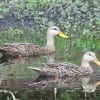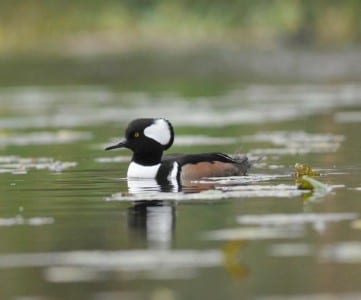 by Jim Stevenson,
by Jim Stevenson,

There are probably more Anhingas in Florida than the rest of the Country combined. They show strong sexual dimorphism and are already courting in South Florida. This is a time when waters are low and fish are easier to catch. Darters like Anhingas have straight bills while cormorants have hooked beaks. Curiously, the latter group has no sexual dimorphism but immatures have brown up front like these female ‘hingas.

Florida has more Bald Eagles than any other state in the Lower 48. An example of Bergmann’s Rule, southern birds (i.e. warmer climate) are smaller than northern ones, such as the Bald Eagles in Washington or Alaska. This is a female, with an almost rectangular bill, and they are larger than their male counterparts.

Burrowing Owls are found in the Florida Peninsula and the Desert Southwest, nottoo unlike caracaras, Scrub-Jays and a few other species. They once spanned the entire South but were separated bythe great ice ages of the Pleistocene, beginning 1.8 million years ago. Non-birds like Indigo Snakes and cougars/panthers have also done this, and armadillos have now “come back together” in their range.

Many species winter in South Florida and not anywhere else in the Country. These Broad-winged Hawks are common and tame here fall through spring and this immature is showing off its dark “moustache” that easily separates it from a young Red-shouldered. The vast majority of broad-wings flyto theTropics, often in flocks of many thousands. Compare this bird to the immature Red-shouldered Hawk on the next page¬Immature Red-shouldereds show the longer shape compared to BW and the tail is less banded. Curiously, this bird is just beginning to attain its reddish barring on the chest. This species occupies a mid-point between heavier buteos and the thin accipiters.


Heavily laden with reddish ventral feathers is the adult Red-shouldered Hawk, perhaps the most beautiful buteo of our country. This species is omnivorous (eats cold- and warm-blooded prey), and in South Florida it’s often warm enough in winter to nail a few reptiles and amphibians like frogs. I have even photographed a RS with a fish!

Red-shouldereds have the scientific name Buteo lineatus, meaning “lined one.” From the back you can really see the lines made of white dots everywhere, adding nicely to the beauty (-oh?) of the species. Despite their omnivorous habits they have much smaller bills than red-tails, by far our most widespread buteo. Oh! 😉 Fairly regular at times in South Florida is the Short-tailed Hawk, which may be seen in this light morph or a very dark morph (most hawks are dichromatic like that). Note the broad, long wings, which artificially (and incorrectly) make the tail appear short. Like a number of “rare” species in extreme Southern US, these are much more common in the Tropics.


Ospreys are (amazingly) a monotypic family, meaning the family only has one species (the Osprey, a worldwide bird). Can you name another bird (Florida species) that’s a monotypic family? Up next. Notice this Osprey’s sharply hooked beak for ripping fish scales and bones, the semi-zygodactyl toe arrangement (one toe is reversible) and a few brown feathers, left over from the juvenile plumage.


The order Gruiformes is dark meat, long-legged birds of (mostly) aquatic areas. They include mostly rails but a few much larger members, very well represented (especially now) in Florida. The Whooping Crane nests in NW Canada and winters in Texas, but the USFWS has introduced them in Florida (unwisely, IMHO). The recent trio of hurricanes nearly wiped them out but a few survived. Notice these have more bands than a parade. Cranes are in Gruiformes on account of their large size, where they obviously grew a form. Please don’t believe that.

Their small cousin the Sandhill Crane has both a diminutive resident population in Florida as well as wintering birds from the North. There is also a non-migratory race in Mississippi, but Sandhills winter from Arizona to Florida. This bird appears to have a tad of its immature, brown feathers remaining, but this artifact may be permanent. Anybody know?

The Limpkin is a medium-sized gruiform that feeds almost exclusively on snails (mollusk and gastropods). They have a loud, ringing call that echoes through the swamp and a long bill that is only thetiniest bit decurved. The white spots serve as ruptive marks, breaking upthe bird’s shape. The vast majority of our Country’s Limpkins reside in Florida. Audubon named this bird after several of his relatives who walked funny. 😉 Gallinules and coots are true rails that have abandoned life within the marsh for an existence in the open, aquatic areas. They have long toes for walking on lily pads and Florida has the mother load of that habitat. Coots and gallinules have frontal shields that protect the birds from briars and such in marshes and a tail that’s short and flicks a lot"


Coots are one of three groups of birds with lobed toes, “flat” webbing that allows for foraging afoot better than ducks can walk. These breed “up North” but winter in the South (especially Florida) in huge numbers. They are largely vegetarians and are hunted (with boat paddles?) for their nasty meat. Cook it in veggies, throw away the coot and eat the vegetables.

Common Gallinules (unwisely changed back from the more-correct term, Moorhen) are the third of our medium-sized musketeers of the rail family. This bird shows they are a tad smaller than duckage, as it’s the same size as one of our smaller ducks, a teal. They don’t have lobed toes like coots but their long toes are great for walking on soft mud and water weeds. Young gallinules are a fourth the size of adults and are “quartinules.” 😉 Another order of birds (there are 27) that starts with “G” and has members about the same size as the preceding order is Galliformes. These are chicken-like birds from small quail to this Wild Turkey. They have a raised hallux (hind toe) and a simple bill for picking up seeds and such off the ground. They scratch for a living and are non-migratory with their short, rounded wings. Domestic turkeys have whitetail tips. Wild Turkeys are exceptionally abundant in Central Florida and the US Congress. "


Glossy Ibis are far more common in Florida than the rest of the US. They’re also one of the few circum-equatorial species, being found all the way around the middle of Earth. Note the narrow, bluish, bare skin that does NOT extend behind the eye (unlike the White-faced further west). Dark ibis have a lot of iridescence, like grackles, except on the side of the head. (That would be ear-idescence.) Had enough?

White Ibis are abundant in Florida, often seen in big flocks alongside the road. (If you can’t find them near roads, there are other avenues.)This bird is just losing the last of its brown, immature plumage. This species has less black in the wing-tips than other white birds whose black reaches the secondaries. The decurved bill is handy for feeding, allowing the ibis to keep its head up while itprobes.

Wood Storks are very common in Florida, nesting in cypress swamps and often feeding alongside roads and neighborhoods. Formerly known as Wood Ibis, they are obviously storks and their name change reflects the AOU’s desire to standardize avian names and correct the nomenclature. The bill is open, as these mighty birds feed by bill-snap reflex, where the beak slams shut involuntarily on any hapless creature who touches the inside of the open mandibles

The Mottled Duck, which used to be called the Florida Duck, is a different race from the one seen so commonly in Texas and Louisiana. The male’s bill is yellower and the hen’s beak has no black pigment, save the nail (front bird). Mottleds breed very early in both ends of the South and often move well away in summer. These are closely-related to Mallards, which sometimes hybridize with them.

Blue-winged Teal are amazingly abundant in Florida, with some of their kind continuing on to the Tropics for winter. The facial crescent on the male breaks up the form of the head (ruptive mark) but females are brown and mottled, like most hen freshwater ducks. Teal have narrow, saber-like wings and reach speeds of nearly 70 mph when chased

Ruddy Ducks are in a group of tropical ducks with stiff, raised tails and thick, squatty bodies. Males in breeding plumage are exquisite but females are camouflaged like hens of many diving duck species. Sometimes the rare Masked Duck sneaks into Florida and is told by having two facial stripes instead of one.

Mergansers are fish-eating ducks with long, toothy bills for holding their prey. This is the Hooded Merganser, very common in the Florida winter, with all its shallow lakes full of minnows. These are smaller than the other mergansers and are sometimes mistaken for Buffleheads. Mergansers bodies are also long, great for catching fast-swimming fish.

 Posted in
Posted in 

























Hi there colleagues, plesasant pieece of writing and pleasant arguments
commented at this place, I amm actually enjoying by these.
Heree is myy web page :: buy instagram followers cheap fast divorce